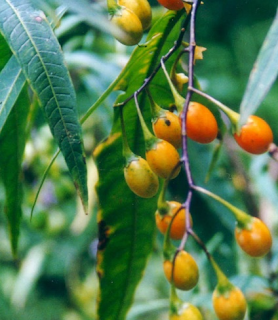Solanum aviculare G. Forst.
Glabrous, unarmed, soft-wooded shrub to c. 3 m tall; stems angular,
green or purplish. Lvs petiolate, 7–35 cm long, entire or pinnatisect
(with 1–4 pairs of lobes extending to c. 10 mm from midrib) on the same
plant. Lamina of entire lvs 2–7–(10) cm wide (lobes of pinnatisect lvs
usually 0.5–3 cm wide, lanceolate or linear-lanceolate, sometimes
elliptic-lanceolate); base decurrent on petiole; apex subacute to
acuminate. Cymes 2–12-flowered; peduncles to 12 cm long and slender at
anthesis; pedicels pendent at fruiting. Calyx 4–7 mm long,
accrescent; lobes broadly triangular, small, mucronate. Corolla
2.5–3.5 cm diam., usually mauve, paler towards margins, occasionally
white, almost glabrous; lobes very broadly ovate, acute, slightly
<to slightly>tube. Anthers 3–4 mm long. Berry 1.5–2.5 cm long,
broadly ovoid or ellipsoid, orange, pendent; stone cells generally not
conspicuous, <seeds. Seed <2 mm diam., ± obovoid and somewhat
asymmetric.
This plant is commonly called as bullibulli,
kangaroo apple in English and poroporo, kohoho in New Zealand. Solanum
aviculare is used in poultice for sores and ulcers. Sap applied to itch
and scabies.
Solanum anomalum Thonn.
This plant is perennial, glabrescent, to 1.5 m tall.
Stems terete at base, drying ridged, branching dichotomously. Petiole
1-3 cm; leaf blade ovate, elliptic, or ovate-lanceolate, 5-18 × 3-10 cm,
papery, base obtuse, margin subentire, apex acuminate or obtuse; veins
arcuate. Inflorescences solitary or up to 12-flowered clusters. Pedicel
1-2 cm, nodding, slightly thicker distally. Calyx cup-shaped, 2-2.5 × 3
mm, truncate. Corolla bright yellow, short campanulate, 5-8 × 6-8 mm;
lobes ovate-deltate, recurved, 2-3.5 mm, minutely ciliolate. Filaments
ca. 0.5 mm; anthers ca. 1.8 mm. Style 2.5-3 mm. Fruiting calyx not
enlarged. Berry shiny, scarlet, 0.8-1.2 cm. Seeds are pale yellow and discoid.
Crushed fruits applied to sores on the ears. Leaves and fruits sap drunk or taken by enema as a treatment for leprosy. Leaf sap drunk against gonorrhea. Fruits laxative, tonic and digestive.
Solanum botelhianum
It is commonly called as amourette blanche in French Guiana. Fruits are used to heal wounds and boils.
Solanum capense L.
In Africa its common names are isiThumana (Zulu), monyaku (South Sotho), umthumana (Xhosa).
Roots of Solanum capense L are used for urinary complaints, syphilis, venereal diseases and snakebite while Leaves used for ophthalmia and toothache.


Comments
Post a Comment